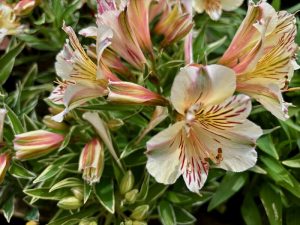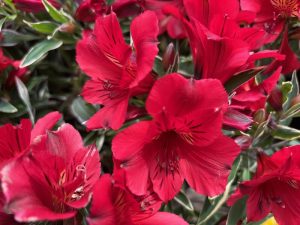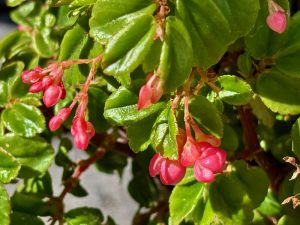Color That Behaves: Alstroemeria ‘Colorita® Princess Fabiana®’ For Containers And Small Gardens
Alstroemeria ‘Colorita® Princess Fabiana®’ steps into a planting with poise and purpose. This compact Peruvian Lily offers creamy-yellow blooms over variegated green-and-white foliage, then keeps flowering for months. Gardeners know it as the Colorita® Fabiana® Peruvian Lily, Princess Lily, and Lily Of The Incas.
You grow it for color, but you keep it for reliability. It stays neat, handles heat with shade, and blooms on and on from late spring well into fall. In a border, it reads as a bright edging plant. In a pot, it becomes a cheerful, repeat-blooming centerpiece that never overwhelms the container. Belonging to the family Alstroemeriaceae, Alstroemeria brings South American verve to modern gardens with a compact habit that actually fits the space you give it.
You see the appeal at first glance. Luminous flowers sit above clean, variegated foliage that stays fresh through the season. Each two-inch (about 5 cm) trumpet opens creamy yellow with a soft golden throat and fine markings on the inner tepals. The foliage carries a crisp white margin that lights up morning and evening shade. Stems stay short and strong, so wind rarely flattens it. Yet the plant still produces stems long enough for cutting, and those stems last in the vase.
Meet Alstroemeria ‘Colorita® Princess Fabiana®’
Plant Alstroemeria ‘Colorita® Princess Fabiana®’ when you need consistent bloom in a compact frame. Expect a tidy mound about 20–30 cm tall (8–12 in) with a spread of 45–60 cm (18–24 in). That size makes placement easy. Tuck it near the front of a border, line a path, or drop one plant per 25–30 cm (10–12 in) pot for a simple, high-impact display. In mixed planters, pair it with fine foliage and vertical accents; it holds the middle without hogging the space.
Variegated leaves do extra work in design. They break up dark green blocks, bounce light, and bring contrast even when the plant takes a short rest between flushes. Because the leaves of Alstroemeria are resupinate (they twist so the underside faces upward), you get a subtle sheen that catches light. The effect reads lively rather than fussy.
A Brief Origin Story
This Princess Lily traces its lineage back to the mountains of Chile and Brazil, where wild Alstroemeria species grow in rich, well-drained soils with steady moisture. Breeders refined those traits into compact, long-blooming garden plants. The Colorita® series—developed by Royal Van Zanten—focuses on patio performance: shorter stems, abundant flowers, and strong, tidy foliage. The cultivar code for Colorita® Princess Fabiana® is ‘Zaprifabi’ (PP 17,991). It’s a clump-forming, tuberous perennial with dependable vigor and a long window of color.
When And How It Blooms
You can count on flowers from late spring through fall. In many regions, first buds open in late May or June and continue in cycles until frost. With regular stem-pulling (more on that below) and steady moisture, the plant resets quickly after each flush. In mild climates, it may push right through autumn. Hot spells slow individual flowers but not the plant; afternoon shade keeps color and foliage quality high.
What Makes The Habit So Useful
Alstroemeria ‘Colorita® Princess Fabiana®’ stays compact and upright, so it never sprawls into a neighboring plant. Stems emerge from a tight crown and rise just above the foliage. Each stem carries a cluster of blooms, so a single pulled stem looks like a small bouquet. Because the plant sits low, you can run a tidy line along a path or mass three to five plants for a bright cushion at the front of a mixed border. In containers, the leaves fill gaps while flowers punctuate the display for months.
Alstroemeria ‘Colorita® Princess Fabiana®’ In Containers
Place it in a container when you want long, reliable color with minimal fuss. Choose a pot 25–30 cm (10–12 in) wide with generous drainage. Use a high-quality, peat-free potting mix amended with 10–20% horticultural grit or perlite for aeration. Set the crown 2–3 cm (about 1 in) below the surface to buffer temperature swings. Water deeply until excess runs from the drain holes, then let the top 2–3 cm (about 1 in) dry before watering again. Feed monthly with a balanced, water-soluble fertilizer during active growth. In hot climates, give the pot morning sun and afternoon shade; the plant will reward you with clean foliage and steady bloom.
How To Grow Alstroemeria ‘Colorita® Princess Fabiana®’
Light
Give full sun to light shade. Aim for at least 6 hours of direct light daily. In regions where summer afternoons reach 32–35°C (90–95°F), move it to morning sun with dappled shade after noon to protect flowers and foliage.
Soil
Plant it in fertile, moisture-retentive but well-drained soil. A loam enriched with compost suits it best. Target a pH between 6.0 and 7.0. In heavy clay, raise the bed 10–15 cm (4–6 in) and mix in coarse grit and well-rotted compost. In very sandy ground, add organic matter to hold moisture.
Watering
Keep the root zone evenly moist. During establishment, supply 2.5–4 cm (1–1.5 in) of water per week, including rainfall. In containers, check moisture daily in hot weather. Water at the soil line to keep leaves dry and reduce disease pressure. Avoid waterlogged conditions; soggy soil leads to root issues.
Fertilizing
Feed in early spring with a balanced, slow-release fertilizer. During the bloom season, switch to a liquid feed every 3–4 weeks to maintain flower production. Avoid heavy, high-nitrogen applications; lush leaves come at the expense of blooms. A top-dress of compost in spring supplies micronutrients and improves soil life.
Temperature and Hardiness
Alstroemeria ‘Colorita® Princess Fabiana®’ performs in USDA Zones 7–10. In Zone 7, mulch in late autumn with 5–8 cm (2–3 in) of leaf mold or bark to protect the crown. In colder zones, grow it in pots and overwinter frost-free, or lift and store the tuberous clumps in a cool, dry place at 5–10°C (41–50°F).
Spacing
Space plants 45–60 cm (18–24 in) apart to allow for air movement and clump expansion over several seasons. In a narrow border, a staggered double row creates a dense, luminous edge.
Mulch
Mulch in late spring to hold moisture and keep the crown cool. Use shredded bark, leaf mold, or fine compost to a depth of 3–5 cm (1–2 in), keeping mulch a few centimeters off the stems.
Planting Alstroemeria ‘Colorita® Princess Fabiana®’
Plant it once soil warms in spring. Dig a hole twice as wide as the root ball and just as deep. Loosen the base of the hole to encourage drainage. Set the crown slightly below the soil surface—about 2–3 cm (1 in)—and backfill with amended soil. Firm gently and water to settle. In windy sites, give the young plant a low, unobtrusive hoop support for the first month; you’ll remove it once new shoots thicken.
Pruning And Deadheading Alstroemeria ‘Colorita® Princess Fabiana®’
Treat spent stems differently from typical perennials. Instead of cutting, grasp a stem near the base and pull with a steady tug. The stem releases from the crown, which signals the plant to push new flowering shoots. Pulling extends the bloom season dramatically. If a stem breaks high, return later and pull the remainder when it softens. In early spring, clear away old, dry stems to make room for fresh growth.
Flowering Season And Cut-Flower Use
From late spring to frost, Colorita® Fabiana® Peruvian Lily cycles through waves of bloom. A single plant can produce dozens of stems across the season. For cutting, pull stems early in the day when the first flower is open and the remaining buds show color. Strip lower leaves, recut the base under water, and place stems in clean water with preservative. Expect vase life of 10–14 days. Replace water every two days to keep the bouquet fresh.
Alstroemeria ‘Colorita® Princess Fabiana®’ In Design
Use the variegation to your advantage. The white margins on the leaves bounce light into shaded corners and cool-toned schemes. Pair it with Gaura, Aster, Crocosmia, and Society Garlic for a meadow-bright mix. In tropical-leaning beds heavy with green foliage, this Princess Lily adds sparkle and rhythm. Along a path, alternate it with dwarf grasses to create a neat, textural edge. In containers, match it with trailing silver Dichondra or chartreuse Coleus to emphasize the creamy throats of the flowers.
Environmental Tolerances You Can Rely On
Heat: The plant handles warm summers, particularly with afternoon shade. In extreme heat, water deeply and mulch; blooms will pause briefly and resume when temperatures moderate.
Wind: Compact height and sturdy stems keep it upright. In very gusty sites, site it near a low wall, hedge, or container cluster for shelter.
Drought:Once established, the clump tolerates short dry spells, but steady moisture yields the best flower count. In containers, drought hits faster; check soil daily in midsummer.
Wildlife: Deer usually ignore Alstroemeria. Bees and other pollinators visit the open throats. Many listings note it as non-toxic to cats and dogs, yet you should still discourage chewing and wear gloves when handling, since some people experience skin irritation.
Propagation Of Alstroemeria ‘Colorita® Princess Fabiana®’
Divide mature clumps every two to three years in early spring or early autumn, depending on your climate. Lift the clump with a fork to avoid slicing the tuberous rhizomes. Shake or wash off soil, then tease the clump apart into generous divisions with several shoots and healthy storage roots. Replant divisions immediately at the same depth and water well. Note the legal part: ‘Zaprifabi’ holds a plant patent (PP 17,991). Asexual propagation without authorization is prohibited while the patent remains in force. Home gardeners can, of course, buy additional plants to expand displays. Commercial growers propagate licensed stock via tissue culture to maintain uniformity.
Pests And Diseases On Alstroemeria ‘Colorita® Princess Fabiana®’
This Princess Lily stays clean when you water at soil level and space plants well. Still, keep an eye out for the usual suspects.
Slugs and Snails: They target tender spring shoots. Place beer traps, use copper tape on pots, or sprinkle iron phosphate pellets around the clump. Morning patrols help, too.
Aphids, Thrips, and Spider Mites: Rinse off small infestations with a sharp spray of water. For persistent pests, apply insecticidal soap or horticultural oil, coating undersides of leaves. Improve airflow and reduce heat stress to deter mites.
Botrytis (Gray Mold): Humid, stagnant conditions invite it. Thin crowded stems, water early so leaves dry quickly, and remove spent stems promptly. If you see fuzzy gray spores on old flowers, discard them in the bin, not the compost.
Root Problems: Soggy ground invites rot. Correct drainage, reduce watering frequency, and avoid wetting the crown in cool weather. In containers, never let pots sit in saucers of water.
Alstroemeria ‘Colorita® Princess Fabiana®’ Through The Seasons
Spring: Plant it after frost when soil warms. Feed lightly. Mulch to conserve moisture. Pull the first spent stems to trigger branching. Watch for slugs.
Summer: Water deeply during dry spells. Provide afternoon shade where temperatures exceed 32°C (90°F). Pull stems for bouquets and to keep buds coming. Feed monthly with a balanced liquid fertilizer.
Autumn: Enjoy the late show; the plant often flowers until first frost. Reduce feed as nights cool. In cold zones, mulch the crown or lift and store clumps. In containers, shift pots to a sheltered spot near the house to grab extra warmth.
Winter: In Zones 8–10, most clumps overwinter in the ground with mulch. In Zone 7, mulch more generously. In colder zones, store lifted clumps in a breathable crate with barely damp peat or coco fiber at 5–10°C (41–50°F). Check monthly and discard any soft pieces.
Alstroemeria ‘Colorita® Princess Fabiana®’ For Small Spaces
When space is tight, plant one at either side of a doorway in matching containers. The scale suits entryways, balconies, and terrace steps. In a townhouse border, stagger three plants along the front edge and weave in blue Salvia and airy Gaura to stretch the color. Because the plant tops out at 20–30 cm (8–12 in), it never hides neighbors. Instead, it frames them.
Troubleshooting Quick Wins
Few Flowers: Increase light. Feed with a bloom-supporting liquid fertilizer. Pull stems rather than deadheading with snips.
Scorched Leaves: Add afternoon shade and water more deeply, less often. Refresh mulch.
Leggy Growth: Too much shade or too much nitrogen. Move to brighter light and switch to balanced feeding.
Wilting In A Pot: Check root zone. If roots circle the pot, upsize by 5–7 cm (2–3 in). In heat waves, water in the morning and again early evening if the top 2–3 cm (1 in) dries quickly.
Buying And Establishment Tips
Choose plants with multiple shoots and firm, white storage roots. Avoid pot-bound specimens with roots spiraling at the base. When you plant, set the crown just below the surface to moderate temperature swings and to anchor stems. Water in with a seaweed-based tonic to reduce transplant stress. For the first two weeks, monitor moisture closely; a steady start sets the tone for the whole season.
Alstroemeria ‘Colorita® Princess Fabiana®’ As A Cut Flower
Pull stems at first bloom, then strip the lower leaves. Recut under water and place in a clean vase with preservative. Keep arrangements out of direct sun and away from ripening fruit. Replace water every two days. Expect 10–14 days of display. The plant responds by sending fresh stems, so you enjoy color both indoors and out.
Companion Planting That Flatters The Princess
Pair Colorita® Fabiana® Peruvian Lily with Gaura for movement, Crocosmia for fiery spikes, and Society Garlic for soft lilac umbels that echo the creamy throats. Asters extend the season at the back half of the border, while dwarf Cannas deliver bold leaves that make the variegation pop. In pots, mix with trailing Bacopa, silver Helichrysum, and a tidy dwarf grass for texture. Keep the palette light and bright; let the variegation do its work.
Frequently Asked Questions About Alstroemeria ‘Colorita® Princess Fabiana®’
Is it hardy in my climate?
Grow it outdoors year-round in Zones 7–10 with mulch at the cool end. In colder zones, treat it as a summer container plant or lift and store the clump.
Does it need staking?
No. The habit is compact and self-supporting. In very windy spots, a low ring during establishment helps.
Is it good for pollinators?
Yes. Bees and other visitors use the open throats and nectar guides.
Is it safe around pets?
Many sources list Alstroemeria as non-toxic to cats and dogs. Still, discourage chewing and wear gloves when handling, as some people experience skin irritation.
How long will it bloom?
With sun, moisture, and regular stem-pulling, expect flowers from late spring to frost.
The Bottom Line
Alstroemeria ‘Colorita® Princess Fabiana®’ brings high performance in a small package. Plant it in rich, well-drained soil. Place it where it receives morning sun and, in hot climates, afternoon shade. Water deeply and keep the crown cool with mulch. Pull spent stems from the base to trigger more blooms. Divide clumps every few years to maintain vigor. In return, this Princess Lily—also known as the Colorita® Fabiana® Peruvian Lily and Lily Of The Incas—delivers months of creamy blossoms over crisp, variegated foliage. It works in tight spaces, plays well in containers, and slides into mixed borders without fuss. Grow it once, and you’ll keep a spot for it every season after.






